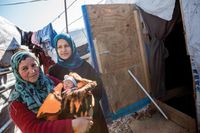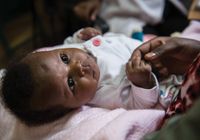
Photo credits: UNICEF/UKLA2014-04618/Schermb
Box 2.1: What is a humanitarian setting?
A humanitarian setting is one in which an event or series of events has resulted in a critical threat to the health, safety, security, or well-being of a community or other large group of people. The coping capacity of the affected community is overwhelmed, in-country infrastructure is disrupted, and external assistance is required. A humanitarian crisis may result from a natural disaster, a technological disaster, or from political turmoil, an armed conflict or other types of social upheaval and often generates mass population displacement, namely refugees and internally displaced persons (IDPsabbreviation). Humanitarian settings can include:
- Urban contexts with refugees or IDPsabbreviation
- Refugee or IDPabbreviation camps
- Informal rural or peri-urban settlements with refugees or IDPsabbreviation
- Settings affected by slow onset disasters, e.g., drought, climate change, famine
- Settings affected by sudden onset disasters, e.g., typhoon, earthquake, fire
- Settings affected by technological disasters, e.g., nuclear explosion, chemical spill, radiation leak
- Settings affected by armed conflict
- Settings affected by an epidemic/pandemic
- Post-conflict settings
- Protracted crisis settings
- Transit areas for populations fleeing violence and persecution
- Settings affected by complex emergencies, which are characterized by significant socio-political disruption, often in conjunction with armed conflict, and a substantial increase in mortality above the population baseline
Humanitarian settings are diverse because of varying baseline mortality, economic development, health system capacity, population dynamics, and local burden of disease. People affected by crises may include vulnerable populations, such as refugees, internally displaced persons, migrants, or local populations. They may live in remote rural areas or camps, but increasingly they reside in urban areas.[1] Humanitarian settings are also increasingly becoming protracted. For instance, intrastate conflicts have an average duration of more than 20 years[2] and displacement lasts for an average of 20 and 10 years for refugees and internally displaced persons respectively.[3]
As such, humanitarian crises threaten the health, safety and wellbeing of a community or a large group of people across a region or a country, not just because of the impact of injuries and illnesses directly related to the crisis, but also because of the destruction of existing health services and systems resulting from the crisis, which exacerbates the toll associated with the usual causes of morbidity and mortality in the affected area. Humanitarian crises can have devastating impacts on newborn health. Neonatal mortality is associated with poor quality maternal and newborn care, weak governance and political instability,[4] and is highest in fragile states and countries that have recently experienced a humanitarian crisis.[5] With disruptions to and decreased access to health services in such settings, unsafe deliveries rise, putting both newborns and mothers at risk (Box 2.2). Sociocultural factors, particularly gender-related norms, may present additional barriers to mothers seeking care for their newborns.
Box 2.2: Quick Facts on newborn health and humanitarian settings
- Newborn deaths accounted for 47% of all under-five deaths in 2020.[6]
- Estimates from 2019 show that about a third of all newborn deaths occur within the first day after birth, and close to three-quarters occur within the first week of life.[7]
- The underfive mortality rate in the 38 countries classified as fragile and conflict-affected situations was 76 deaths per 1,000 live births in 2020, a three-fold increase in risk compared to all other countries.[6:1]
- Nearly 43 per cent of the global under-five deaths in 2020 occurred in fragile and conflict affected situations[6:2]
- More than 29 million babies were estimated to be born into conflict-affected areas in 2018[8]
- Between 2018–2020, it is estimated that an average of 290,000 to 340,000 children were born into a refugee life annually, and while children account for 30% of the world population they make up 42% of all forcibly displaced people.[9]
Rebuilding health facilities and systems, providing emergency care and training health workers form critical components of any humanitarian response, and MNHabbreviation services comprise key components within that process. However, advocacy to health actors is often necessary to ensure newborn services are prioritized from the beginning of an emergency response. (See Section 4.1 for more information about advocacy and coordination.)
Response and recovery efforts should, to the extent possible, build on existing health structures, promote resiliency and support long-term recovery of health systems. Respectful partnerships with development organizations, particularly local organizations and governmental agencies, as well as crisis-affected communities, are essential for a successful response and recovery (Box 4.1). Identifying and addressing local political and governance barriers can also facilitate program implementation. To promote accountability and support a rapid and effective response, newborn health considerations should be integrated into emergency preparedness and disaster risk reduction efforts before a crisis occurs.
2.1.1 Challenges to Newborn Health Service Delivery
Humanitarian settings are characterized by myriad challenges that threaten the health of communities, including newborns and their mothers:
Service disruption and facility destruction
This could include the breakdown of prevention programs, such as vaccination, vector control and disruption of supply chains; reducing access to medicines and other commodities; shortages of health care providers and other health staff; reduced access to other essential services such as water, sanitation and hygiene, and nutritious foods; unusable roads; and lack of transport vehicles.
Population movements
Inability to access services among mobile populations, crowding in locations housing IDPsabbreviation and refugees.
Competing priorities
Injuries and displacements overwhelm existing health facilities and programs, rendering them unable to cope with the additional strain of urgent newborn care; funding may be routed to other areas of acute need, such as injury treatment and prevention and management of life-threatening epidemics and pandemics (e.g. cholera, COVID-19) within the child and adult populations.
Lack of safety
Threats to the security and safety of affected populations and the staff working to support them hinder access to and delivery of health care to women and babies before, during and following childbirth. Curfews, lack of transport and other logistical challenges prevent women from accessing skilled birth care at health facilities when they need it.
Preventing serious illness and death among newborns requires that care be available, functional and tailored to the local situation. In humanitarian settings, the coping capacity of the affected community is overwhelmed, and external assistance is brought to the affected area. Staff designing and managing humanitarian health programs have a responsibility to ensure that, where available, national protocols in line with WHOabbreviation guidance are followed; otherwise protocols based on WHOabbreviation guidanceinfo should be put in place to guide the provision of appropriate newborn care. Service providers should be competent and enabled to offer BEmONCabbreviation, CEmONCabbreviation(or appropriate referral), ENCabbreviation, PNCabbreviation, and identification and basic care for sick or small babies (or appropriate referral).
In line with target 3.2 of the 2030 Sustainable Development Goals and the Every Woman, Every Child’s Global Strategy for Women, Children, and Adolescents’ Health (2016-2030),[10] the Every Newborn Action Plan[11] aims to reduce newborn mortality and stillbirths to at least as low as 12 per 1,000 live births in every country by 2030; efforts to decrease neonatal deaths and stillbirths in humanitarian settings are critical to achieving this target as outlined in the Roadmap to Accelerate Progress for Every Newborn in Humanitarian Settings.[1:1]
Box 2.3: Managing Newborn Health Care in High-Risk Settings
Threats to safety and security are an unfortunate reality for pregnant and postnatal women, their families and the humanitarian health workers serving them within crisis settings. Safe access to health services for the crisis-affected population must be prioritized:
- Establish temporary health outposts/facilities as close as possible to the crisis-affected communities
- Provide mobile services when feasible and when the security situation allows
- Deploy appropriately trained home visiting staff (community health workers or others) who can safely reach pregnant and postnatal women in their households
- Engage communities and ensure they have up-to-date information regarding how to access providers, such as a list of health providers in the camp or area and phone numbers for providers on call, including midwives and doctors from the affected community who are able to provide care
- Ensure that health workers have the supplies they need, and are trained to detect newborn danger signs, treat life-threatening newborn conditions to the greatest extent possible and transfer pregnant and postnatal women to referral facilities (or hospitals) when the security situation allows
See Chapter 4 and Chapter 5 for guidance on developing and implementing newborn health services in crisis settings.

